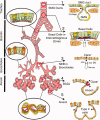National Heart, Lung, and Blood Institute perspective: lung progenitor and stem cells--gaps in knowledge and future opportunities
- PMID: 19522010
- PMCID: PMC2962803
- DOI: 10.1002/stem.148
National Heart, Lung, and Blood Institute perspective: lung progenitor and stem cells--gaps in knowledge and future opportunities
Abstract
Because the lung stem cell field is so new, there remain many unanswered questions that are being addressed regarding the identification, location, and role of exogenous and endogenous stem and progenitor cell populations in growth, regeneration, and repair of the lung. Advancing lung stem cell biology will require multidisciplinary teams and a long term effort to unravel the biologic processes of stem cells in the lung. While no clinical research in lung stem cell therapies are currently funded by NHLBI, the knowledge gained by understanding the basic biology of the lung stem cell populations will be needed to translate to diagnostic and therapeutic strategies in the future.
Figures


Similar articles
-
An official American Thoracic Society workshop report: stem cells and cell therapies in lung biology and diseases.Ann Am Thorac Soc. 2015 Apr;12(4):S79-97. doi: 10.1513/AnnalsATS.201502-086ST. Ann Am Thorac Soc. 2015. PMID: 25897748 Free PMC article.
-
Stem/progenitor cells in lung development, injury repair, and regeneration.Proc Am Thorac Soc. 2008 Aug 15;5(6):703-6. doi: 10.1513/pats.200801-012AW. Proc Am Thorac Soc. 2008. PMID: 18684721 Free PMC article. Review.
-
Stem cells and cell therapies in lung biology and lung diseases.Proc Am Thorac Soc. 2011 Jun;8(3):223-72. doi: 10.1513/pats.201012-071DW. Proc Am Thorac Soc. 2011. PMID: 21653527 Free PMC article.
-
Portfolio analysis on preeclampsia and pregnancy-associated hypertension research funded by the National Heart, Lung, and Blood Institute.Physiol Genomics. 2018 Nov 1;50(11):982-987. doi: 10.1152/physiolgenomics.00093.2018. Epub 2018 Sep 28. Physiol Genomics. 2018. PMID: 30265594 Free PMC article.
-
Stem cells of the adult lung: their development and role in homeostasis, regeneration, and disease.Wiley Interdiscip Rev Dev Biol. 2013 Jan-Feb;2(1):131-48. doi: 10.1002/wdev.58. Epub 2012 May 3. Wiley Interdiscip Rev Dev Biol. 2013. PMID: 23799633 Review.
Cited by
-
Cell-based strategies to reconstitute lung function in infants with severe bronchopulmonary dysplasia.Clin Perinatol. 2012 Sep;39(3):703-25. doi: 10.1016/j.clp.2012.06.009. Clin Perinatol. 2012. PMID: 22954277 Free PMC article. Review.
-
Stem/Progenitor Cells and Related Therapy in Bronchopulmonary Dysplasia.Int J Mol Sci. 2023 Jul 7;24(13):11229. doi: 10.3390/ijms241311229. Int J Mol Sci. 2023. PMID: 37446407 Free PMC article. Review.
-
BMP signaling regulates the differentiation of mouse embryonic stem cells into lung epithelial cell lineages.In Vitro Cell Dev Biol Anim. 2013 Mar;49(3):230-7. doi: 10.1007/s11626-013-9589-1. Epub 2013 Mar 7. In Vitro Cell Dev Biol Anim. 2013. PMID: 23468359
-
Regenerative pulmonary medicine: potential and promise, pitfalls and challenges.Eur J Clin Invest. 2012 Aug;42(8):900-13. doi: 10.1111/j.1365-2362.2012.02667.x. Epub 2012 Mar 21. Eur J Clin Invest. 2012. PMID: 22435680 Free PMC article. Review.
-
Pulmonary Sensory Receptors.Adv Anat Embryol Cell Biol. 2021;233:1-65. doi: 10.1007/978-3-030-65817-5_1. Adv Anat Embryol Cell Biol. 2021. PMID: 33950466 No abstract available.
References
-
- Rawlins EL, Okubo T, Que J, et al. Epithelial stem/progenitor cells in lung postnatal growth, maintenance, and repair. Cold Spring Harb Symp Quant Biol. 2008;73:291–295. - PubMed
-
- Weiss DJ, Berberich MA, Borok Z, et al. Adult stem cells, lung biology, and lung disease: NHLBI/cystic fibrosis foundation workshop. Proc Am Thorac Soc. 2006;3:193–207. - PubMed
MeSH terms
LinkOut - more resources
Full Text Sources
Other Literature Sources
Medical

